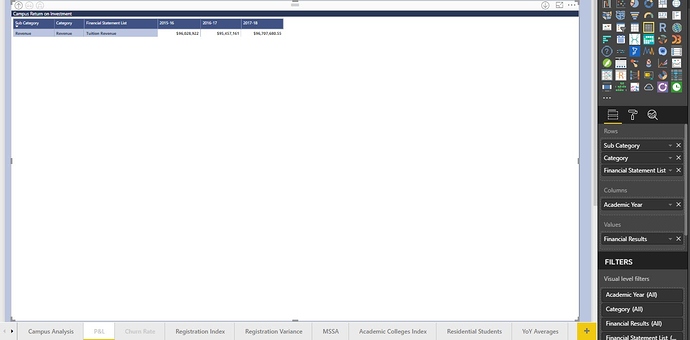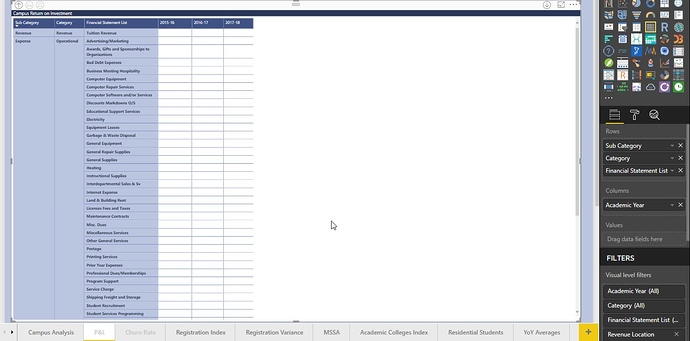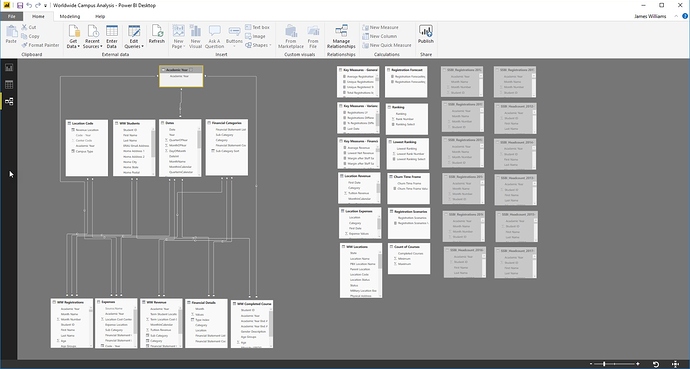So Leveraging the video on Integrated Financial Reporting and the one on PnL Statements I came close to what I wanted to show which was revenue and expenditures in the same table. Because my revenue and expenditures did not come in the same file/table I had to do some creative stuff. The Revenue is born out of the Registrations data table which is the sum of tuition paid by student per class in the academic year.
When using the below for financial results the only thing that shows up in the data table is the Revenue this is why I am thinking that something is wrong with it even though the table that its drawing from called ‘Financial Details’ was successfully created reflecting revenue and expenditures for locations.
Financial Results = SUM('Financial Details'[Values])
To extract Revenue from my Registrations table I used the following:
WW Revenue =
SUMMARIZE('WW Registrations', 'WW Registrations'[Academic Year], 'WW Registrations'[Term Student Location], 'WW Registrations'[Term Location Cost Center], Dates[MonthInCalendar], "Tuition Revenue", SUM('WW Registrations'[Class Price]))
Then created ‘Location Revenue’ using the following:
Location Revenue =
SUMMARIZE('WW Revenue', 'WW Revenue'[Term Student Location], 'WW Revenue'[Financial Statement List], 'WW Revenue'[Financial Statement Code], Dates[MonthInCalendar],
"Category", "Revenue",
"First Date", MIN(Dates[Date] ),
"Tuition Revenue", [Revenue Total] )
From my Expenses data table which I do not have to extract from some other table I created ‘Location Expenses’ using the following:
Location Expenses =
SUMMARIZE('Expenses', Expenses[Expense Location], Expenses[Financial Statement List], Expenses[Financial Statement Code],
"Category", "Expenses",
"First Date", MIN(Dates[Date] ),
"Expense Values", [Overall Expenses] )
The ‘Financial Details’ table is created from the following:
Financial Details =
UNION( 'Location Expenses',
SUMMARIZE('WW Revenue', 'WW Revenue'[Term Student Location], 'WW Revenue'[Category], 'WW Revenue'[MonthInCalendar], 'WW Revenue'[Tuition Revenue], 'WW Revenue'[Financial Statement List], 'WW Revenue'[Financial Statement Code]))
My desired outcome is to be able to show Revenue and Expenditures like presented in the videos but specific my scenario which would be based on the actual Campus Location followed by Revenue and Expenditures and their subcategories by academic year.
With the [Financial Results] measure below is the output which is the correct values for the Revenue but Expenditures don’t show even though they are int he same column in the table that the measure draws from.
Financial Results = SUM('Financial Details'[Values])
If I remove the [Financial Results] measure from the table then I see all columns like below but of course, there are no values because there is no measure. But this is how the table would look if it were populating the amounts.
There are some months where there is no revenue or expenditures so I dont know if that somehow causes a problem in the output. I just can’t think of what I am missing.


